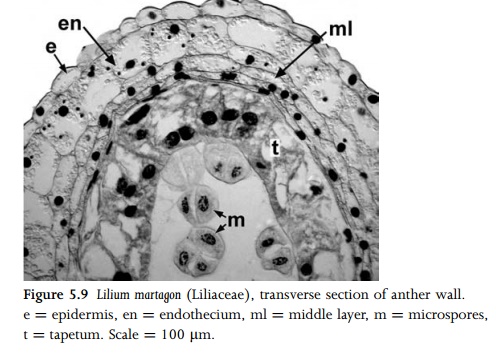Chapter: Anatomy of Flowering Plants: An Introduction to Structure and Development : Flower
Androecium
Androecium
The
stamens are the pollen-bearing (male) organs. They typically consist of a stalk
(the filament), and the pollen-producing part, the anther, which consists of
four microsporangia separated into two pairs (thecae), linked by a connective.
Each theca possesses two sporangia or anther locules divided by a septum.
Stamen
filaments are typically slender and cylindrical, but in some species they are
flattened and leaf-like (e.g. inNymphaea odorata) or even branched (e.g. in
Ricinus communis). In many polyandrous angiosperms the stamens are borne in
groups (fascicles). As in other floral parts, the filament surface often bears
trichomes, stomata and surface patterning. In transverse section the filament
possesses a parenchymatous ground tissue surround-ing the vascular tissue,
which normally consists of a single vascular bundle.
The
anther wall consists of several layers of cells. The epidermis normally
undergoes only anticlinal divisions during development. The other anther wall
layers are all derived from the primary parietal cells, which arise from the
same initial cells as the primary sporogenous cells. The two most distinct
anther wall layers are the endothecium, which lies immediately within the
epidermis, and the tapetum, which is the innermost layer of cells surrounding
the

anther
locule (Fig. 5.9). Intervening layers usually consist of thin-walled cells that
are often crushed and destroyed at anthesis. Endothecial cells typically
develop fibrous wall thickenings which contribute to the anther dehiscence
mechanism.
The
tapetum is a specialized cell layer that functions as a source of nutrients for
developing pollen grains. Tapetal cells are secretory and contain dense
cytoplasm. They produce exine precursors, proteins and lipids that form the
pollen coat. In many species a layer of tapetal cells remains intact around the
anther locule; this type of tapetum is termed the secretory type (or cellular,
glandular or parietal). In some other species the tapetal cells degenerate and
their protoplasts fuse to form a multinucleate tapetal plasmodium (a
periplasmodium) in the anther locule; this type of tapetum is termed the
plasmodial type (or amoeboid, invasive, periplasmo-dial or syncytial type).
Transitional types also occur in some species, especially in magnoliids.
Related Topics